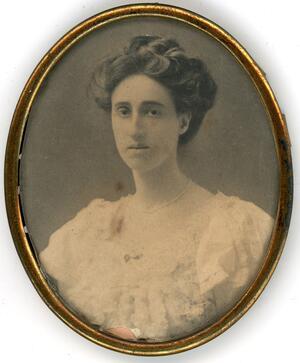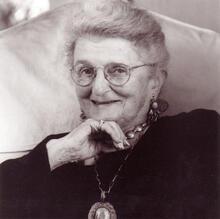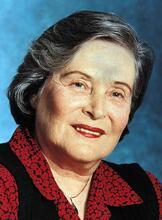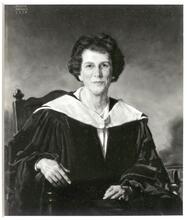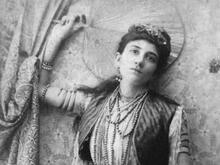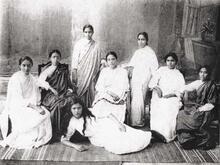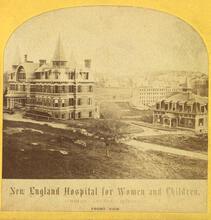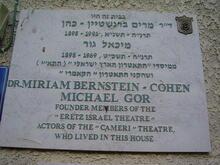Esther Rosencrantz
Esther Rosencrantz was ahead of her time as a doctor and tuberculosis researcher, but she is most remembered for her research on her mentor, Sir William Osler. Rosencrantz studied chest diseases with Osler at Johns Hopkins, the school he helped found, and graduated in 1904. She spent the next decade studying tuberculosis around the world before becoming a professor at the University of California, San Francisco, and head of the San Francisco Hospital tuberculosis clinic. After World War I she joined the Red Cross Tuberculosis Commission in Italy for two years before returning to teaching. While she was respected greatly for her own work and teaching, she was devoted to researching Osler, who is credited with creating the medical residency, where medical students learned by working with patients under supervision.
Education and Early Research
intense interest in Sir William Osler, her mentor, which pervaded her adulthood and was her legacy. Rosencrantz was born on November 18, 1876, in San Francisco, California, the daughter of John and Bertha (Wertheimer) Rosencrantz. She grew up on Sixth Street, in a working-class Jewish neighborhood. A graduate of Stanford University (1899), Rosencrantz studied chest diseases with Osler at the Johns Hopkins School of Medicine. In 1904, she became the second California woman to receive a Johns Hopkins medical diploma. She interned at the New York Infirmary for Women and Children, and for the next decade pursued clinical research and practice in the field of tuberculosis in London, Berlin, Paris, and Bern.
Work on Tuberculosis, Research with Osler
In 1913, Rosencrantz began a long career as a clinical professor of medicine at the University of California, San Francisco (UCSF), where she served as a specialist in pulmonary diseases. She was in charge of the University of California Tuberculosis Clinic at the San Francisco Hospital, and was a trustee or consultant for a number of tuberculosis treatment facilities in northern and central California. Rosencrantz often visited needy patients at home, providing them with food, milk, and medications at her own expense. At the end of World War I, she was a member of the Red Cross Tuberculosis Commission in Italy, serving overseas for two years, and was honored by the Italian government for her work there.
In addition to her medical research, practice, and teaching, Rosencrantz became a member of the Division of Medical History and Bibliography at UCSF, focusing on William Osler (1849–1919), who was the most prominent and respected American physician in modern medical education. She collected any materials she could lay her hands on that were related to her beloved teacher. Earl Nation, M.D., of the American Osler Society refers to Rosencrantz as “Osler mad,” noting that she saved “tufts of grass and shrubs on which Osler had trod!”
Later Work and Legacy
Rosencrantz retired as associate professor of medicine in 1943 after several years of being edged out of financial and office support. She registered her displeasure in letters to university officials, offended by their treatment in light of her long and successful service to the university. She continued to work as a volunteer in the Division of Medical History, expanding and cataloguing her Osler collection. By 1948, she had apparently resigned herself to her constrained circumstances in the medical school, writing to the dean: “in spite of all—and in the words of Osler ... to have striven, to have made an effort, and to have been true to certain ideals—this alone is worth the struggle.”
Little is known of Rosencrantz’s life as a Jew. Her collected papers, maintained by the UCSF Library Archives and Special Collections, reveal little interest in or contact with Jewish people or institutions. Her death from heart disease on December 18, 1950, however, was written up in San Francisco’s Jewish Community Bulletin, and Alvin Fine, rabbi of Temple Emanu-el, the city’s largest Reform congregation, officiated at her funeral service.
Rosencrantz led a remarkably adventurous life for a woman born in late nineteenth-century America. Attending Johns Hopkins when it was the foremost institution at the dawn of scientific medical education in the United States, her work was with the disease that was the major cause of morbidity and mortality of the era. Her coerced retirement coincided with the decline of tuberculosis. She assimilated into the dominant culture, like many California Jews, and a great man became her heritage.
BEOAJ; “Esther Rosencrantz, Medical Educator, 74.” NYTimes, December 19, 1950: 29:4.
Gilcreest, Edgar Lorrington. “In Memoriam—Esther Rosencrantz.” Bulletin of the San Francisco County Medical Society (March 1951): 18+.
Nation, Earl F. Ester Rosenkrantz, MD and Her Collection of Osleriana (1996).
“Obituary—Dr. Esther Rosencrantz.” Jewish Community Bulletin (December 22, 1950): 6.
Rosencrantz, Esther, Papers. Special Collections/University Archives, The Library and Center for Knowledge Management, University of California, San Francisco, and “Posthumous Tributes to Sir William Osler.” Archives of Internal Medicine 84 (1949): 170–197.
Sigerist, Henry E. “William Osler (1849–1919).” In The Great Doctors (1958).
UJE; Who’s Who in California, 1942–43 I (1943): 784 WWIAJ (1938).

